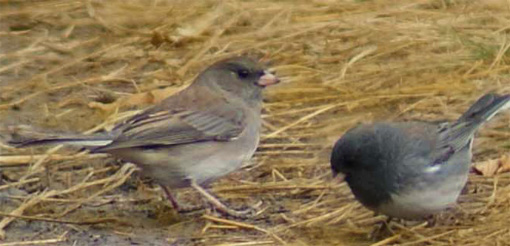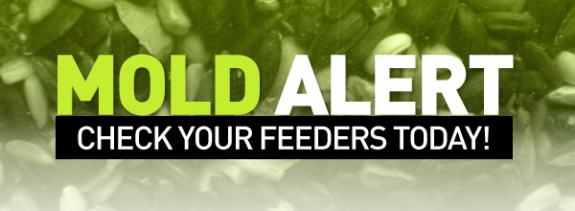Due to the recent extended rain, dangerous molds and fungus can be developing in the bottom of your bird feeders. Even though we’d recently cleaned our own feeders, they were shamefully DISGUSTING!!! Finding them in this state alarmed us so much, we thought we should spread the word.
Hot & Soapy Water. Soak. Scrub. Rinse Well.
It’s that simple. Please, we urge you to check your feeders ASAP. If you see mold, or the seed is clumping (a sign of pre-mold dampness), dispose of the seed and clean the feeder thoroughly with hot soapy water, as stated above. Also, rake up any shell debris on the ground below your feeders. It will likely have mold, too.
Moldy bird seeds, nuts and suets can be deadly! We need to take this seriously, as birds can contract diseases from inhaling mold/fungus spores.

Ewwwww!!! Mold?! Not the way we want to welcome back our White-throated Sparrows and Juncos!!! ( Male and female Juncos pictured above. ) These visitors feed almost exclusively on the ground alongside resident Cardinals.
Check your feed supplies indoors, too!

Don’t forget to check your stored food, too.
Check all your stored seed, nuts and suets. It should smell fresh and nutty. If you notice any unpleasant musty smell or clumping, it’s gone bad. Throw it away and replace with fresh!
We can’t over-emphasize how important it is to keep your wild bird food fresh and your feeders clean, dry and uncontaminated. After all, we make sure our human restaurants achieve sanitation standards with routine inspections to protect us from spoiled food.
As good stewards, it’s up to us to do the same diligence for our backyard feeder customers. Wild birds may be less discerning than we are, but they’re just as vulnerable when food goes bad!
And now the good news: it’s not hard to remedy this situation–even if you find your feeders as disturbingly moldy as ours were! It just takes some hot, soapy water, a good scrub, and a rinse with clean water!
We’ll need to be vigilant, even into Winter. Our current Autumn temperatures may slow growth of the icky stuff, but get this…It doesn’t die–even at 0°F– it just goes dormant and waits for the temperature to rise again. But, we shouldn’t wait.
Our wild birds will thank us by continuing to grace our backyard feeders in good health.
Thank you for reading!
Debi






